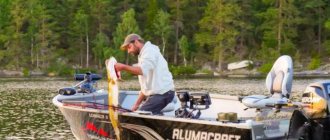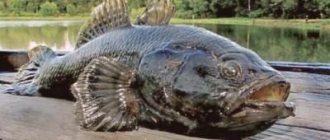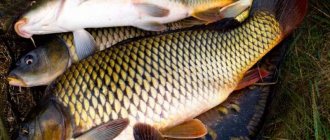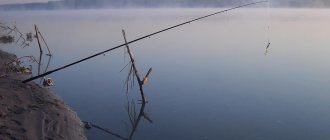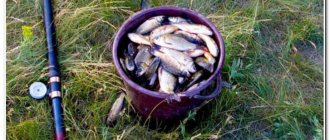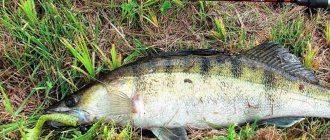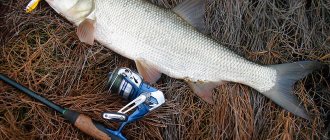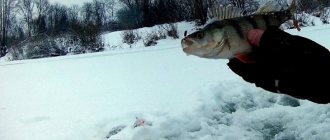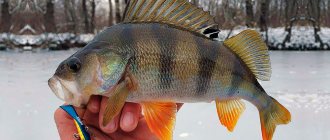Perch in August, features of fish behavior
In principle, the August behavior of perch is practically no different from its behavior in other summer months; this fish is completely predatory, and also quite voracious, therefore, for the most part, it always rushes at any prey, even if it is not hungry at the moment.
There have been situations when experienced fishermen noticed that perches, not being hungry, pounced on small fish and killed them; the killer and predator instinct simply kicked in.
During the August days, fishing for this fish can be carried out almost throughout the day, from dawn to sunset. In this month, perch most prefers to carry out its hunting processes closer to the surface of the reservoir, where the water is better warmed up; in these layers there are more small fish, which are prey for perches.
The process of feeding this fish in August is to feed it with worms, or use small fresh bones, which should have small pieces of meat on them. Moreover, feeding processes need to be carried out only when there is a fairly sluggish degree of fish bite.
When air pressure changes, the bite decreases. A more favorable fishing period will be a lightly drizzling rain, but it should be warm outside. After fairly heavy rains, there is also an increase in perch activity.
Tackle and features of fishing at the end of summer
Spinning fishing
Catching perch in August with a spinning rod involves using a wide range of different baits. But the gear for this compact hunter of fry and tadpoles remains the same. In fresh river and lake water, the striped fish rarely reaches large sizes. For this reason, it makes no sense to take a spinning rod with a rod greater than 20 test. The easier it is, the more subtle, even jewel-like, the game will be.
During this warm season, braided fishing line is used due to its greater strength compared to monofilament. In general, it is better to take a heavy-duty jig spinning rod with you, made of carbon fiber and covered with a waterproof film on top. Its handle should ideally be made of neoprene. The length of the rod for fishing from the shore is from 2.20 to 2.70 centimeters and for a boat - from 1.80 to 2.20 centimeters, respectively.

The reel system does not play a key role here and you can use both inertia-free and slightly less popular inertial, as well as even the latest multiplier - the result in all cases can be approximately the same.
For the most part, a non-inertia model with an open spool is used for catching perch, because such a mechanism allows you to launch the bait into flight over quite noticeable distances, while practically not losing the accuracy of this throw.
In general, fishing with a spinning rod in the last month of summer for an active striped river predator can be carried out both from the shoreline and from the embankment, from the pier or from a boat. Fish are everywhere at this time and you can find them almost anywhere.
Fishing with a float rod and lure
Catching perch in August with a float rod and a simple spoon is now considered a rather outdated way to achieve what you want. However, they do not forget about this method, but as a rule, these are older people who are accustomed to a simple state of affairs.
In the old days, there was not that almost limitless variety of all kinds of shapes and colors of spinning rods, reels, jigs and other delights that now lie in bulk on store shelves. They had a bamboo stick, fishing line and homemade equipment, and a jar of recently caught earthworms.

In this situation, the range of necessary actions is narrowed down to elementary casting and tugging on the rod. At the same time, in August you can easily catch perch in such a simple way, so there is nothing wrong with that.
The length of the rod should exceed 2.5 meters, otherwise there are no special recommendations here, and even after the detailed selection of spinning tackle described, there cannot be any. Use the same things as for the more modern redfin hunting tool.
Fishing with a jig
August is also notable for the fact that in practice it allows the use of the widest range of all kinds of gadgets that modern fishermen, spoiled by the blessings of civilization, so love to dabble with. One of the most beloved baits is the many-faced jig. What varieties of it have not already appeared: goat, devil, jellyfish, carnation, uralochka - choose any, or better yet, take a few with you in reserve.

One of the most universal forms is just the carnation; you can grab it together with a little uralochka and you will be happy. It doesn’t bite on the first type, which means it’s time to safely use the second one, which is intended for such moments of downtime.
They are especially effective where other baits can get caught on protruding snags or get tangled in the grass. Jigs will be equally effective at any time, including in conditions of limited visibility, thanks to their famous ability to bypass all obstacles without the direct participation of the initiator in this process.
Fishing on a balance beam
The balancer is a slightly less successful find, and not because it is ineffective, far from it. This is a completely successful invention; it often breaks down too quickly and only an experienced professional can guess about it. A beginner will hardly be able to understand what is the reason for his failure. This thing is suitable for throwing from a boat where the possibility of snagging is minimized.

Fishing with a retractable leash
Catching perch in August on a retractable leash is the destiny of selected masters. Catching a trophy with this complex but effective tackle is extremely difficult. A beginner should be happy if he manages to hook a 25-centimeter dodger onto a leash. The use of attachments painted in bright colors with this equipment is undesirable. Otherwise, this thing will perform its best in water against the current, as well as in lakes and reservoirs where the current is either completely absent or rather weakly expressed.

Donk fishing
If the sky is cloudy, it’s raining, the wind is blowing, but you still want to go fishing, a good option would be to use donks to catch a trophy humpback whale. You can cast it both from the shore and from a boat. The jig has proven itself to be the best when working with donka. The coil is more appropriate here - inertial. But we should not forget that for effective fishing with this tackle, the initial depth should not be less than three to four meters.

Choosing a fishing spot in August
A predator like striped bass loves places where there is a lot of grass and mud. Therefore, it is better to look for it in such places. The best thing to do if you want to catch this striper is to buy a boat. This type of movement will help you get as close as possible to such places.
The best place to catch a striper is where the reservoir has a lot of large thickets. Also, in order to find the exact habitat of a predator, you will need a special device. It's called an echo sounder, and this device will definitely help you determine the place where especially large striped bass live.

To catch perch in August, the best place will be the top layer of overgrown reservoirs. Since during this period of summer time, perch are looking for food. And to find small fish, they need to swim as close to the surface as possible.
If you want to catch these small striped predators, you can do without a boat. Medium-sized perch can be easily caught from the shore. In order to accurately anticipate the habitat of the perch, first of all, you need to decide what size fish you want to catch.
Larger specimens of the predator in August should be looked for at the very bottom of the reservoir. Smaller individuals are easier to catch; you need to look for them where the fry appear. After all, the striped predator needs to eat, so it swims almost to the surface and goes into the hands of the fisherman.
Features of behavior
Feeling the approach of autumn, perch begins to show increased activity in August. On days with suitable weather, striped fish can hunt almost all day, from dawn to dusk, which means they can also be caught throughout the daylight hours. This predator prefers relatively shallow backwaters, with a lot of vegetation and snags, in the middle of which it sets up ambushes. Often, perch also gather near the supports of bridges, dams and similar structures. You can find striped fish under steep banks, as well as in places where tributaries flow into the main channel.
At the same time, we should not forget that in late August and early September, perch often stands close to the shore, so you should approach a new fishing spot as carefully and quietly as possible, so as not to scare away the fish lurking nearby. The first casts should also be made relatively close and lead the bait along the shore.
What bait is best for catching perch in August?
Perch is a predatory fish and can be caught using any type of bait. To catch this whimsical fish in August, you need to choose the most interesting types of bait that will definitely work. In order to catch perch in August, you can try to lure it with artificial spoons that have a rotation effect.
Read this article about the best ways to catch perch in June.
It is best if you choose this type of spoon, a special color that will help you catch this fish. The colors of the spinner should be light shades, white and yellow. They are the best, according to experienced fishermen. You can also choose spoons that are sold in fishing stores with luminous stickers. They are ideal for catching predatory fish in the summer, and especially in August, when it is no longer so hot.
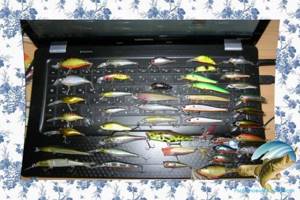
You can also catch this whimsical predator using wobblers, but you need to choose this type of bait correctly. Popper and walker are perfect for hunting aquatic predators in August. A good option, as experience shows, would be a silicone bait for the striped inhabitant of lakes and rivers.
Such devices are most often used by fishermen who use spinning rods. These types of baits are very convenient and easy to use, and most importantly, they are sold in the form of small insects and grasshoppers. Perches are good at taking such bait, thinking that it is real food.
Spinning fishing - necessary gear
Catching perch in August with a spinning rod will require certain features from your gear. Since the baits used to catch the striped predator are relatively small, a suitable spinning rod is needed - with a weight of up to 8-10 grams, no more (rods that are too powerful do not work well with miniature baits). The preferred action is fast or ultra-fast, which will allow you to effectively use the entire variety of baits. This rod will allow you to work with both edible rubber and wobblers, including those that involve the use of jerking retrieves.
Features of perch fishing in August
Among the peculiarities of catching perches in August, it is worth noting the fact that you can use such a technique as scattering several handfuls of ordinary sand over the surface of the reservoir. This technique will create an effect of such a nature that the perches will begin to think that schools of small fish are scattering, so this action will certainly attract the attention of the perch representatives. At this moment, you should not yawn, but you need to carry out the process of throwing.

It should also be noted that when fishing for small fish among perches, the hooks swing with this little thing. Larger individuals begin to go to the depths, which is why the float is flooded. To catch large perches, you must have a landing net with you.
Live worms will be an excellent bait in August. The perches themselves perfectly remember the place where they had a successful hunt. When hooking, you should not make too sharp jerking actions, because you can tear the lips of the fish with the hooks. These fish should be caught from the leeward side.
Perch fishing in autumn
Autumn is a favorable season for hunting perch with a spinning rod. Probably, fishing for perch in no other season evokes as much emotion and adrenaline as autumn fishing for this striped predator. The reasons for this increase in perch bite are very simple: cooling water, activation of small fish in the upper layers of water, gathering of small schools of perch into large schools.
Perch is an active predator. Almost all year round he chases small fish. However, in summer, medium-sized perches live in schools of several dozen individuals. Large perches (more than 300-400g) are kept in groups of 5-10 individuals. And the largest humpback whales, per kilogram, try to stay apart or in pairs. It is clear that the summer strategy for catching perch is to find a school, thin it out as much as possible before the fish are scared away, and look for the next small school.
In autumn everything changes. Small and medium-sized schools of perch unite into denser schools, numbering several hundred tails. In such “collectives” there can be both yesterday’s “sailors”, about the size of a palm, and humpbacks, up to a kilogram (the largest ones will still be kept separately). Of course, discovering such a large and hungry school is a guarantee of a brilliant catch. We have already talked about fishing in “cauldrons”. But let’s touch again on the tactics of searching for a school of perch.
In search of prey, perches follow large concentrations of small fish and algae. Such schools of small fish are clearly visible on the surface of the lake, by small circles on the surface and rare, weak splashes. If such schools are attacked by a predator with splashes, then your chances of catching increase. With such a concentration of small fish you can catch good perches and hook a good pike, or even more than one.
When fishing on a large lake or reservoir and because of the waves it is impossible to find a flock of small fish, you should be guided by the seagulls circling above the water. There will be a flock of little things there, and therefore greedy autumn predators.
As for equipment. Of course, it is more convenient to track large schools of perch by moving around a body of water in a boat. It is not always possible to get perches from the shore. Tackle – light, comfortable spinning rod, thin cord or fishing line. Spinning rod action – fast or medium. Bait is important only if the flock does not form cauldrons and is not very active. If the perch is fattening, you can literally fish with a cigarette butt and a tee...
And yet, the following baits are preferable: small and medium (5-7cm) twisters and vibrotails on light jig heads”; small and medium-sized turntables with cores (No. 1 - No. 3); medium-sized wobblers crank, minnow; medium poppers.
As for the techniques of presenting and retrieving the bait - when the perch is active, this does not really matter... But basically, for jig baits it is an easy step in the water column; for spinners - smooth, uniform movement near the surface or into the floor of the water; for wobblers - the most optimal wiring for a specific model. And remember, perch prefers baits with a high frequency of rotation (oscillation). Pike, on the contrary, in most cases will prefer a smooth, sweeping action of the bait.
In autumn, an active school of perch, as a rule, stays in half the water and often comes to the surface. More rare are the cases when perches are completely passive and then sink closer to the bottom. However, this is usually associated with changes in atmospheric pressure and you can’t count on a bite in such cases. Perhaps very small perches will show curiosity, against the backdrop of the general passivity of the school.
Tackle for perch fishing in August
Fishing for stripers in the late summer season is best done using float rods. To create floats, use cork material, or you can use the bark of a tree such as sedge. When attaching the sinker, it should be located at a distance of about twenty centimeters from the hook itself.
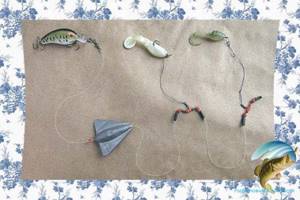
Shore catching of perch should be carried out with fishing rods that are equal in length to two and a half meters, or three meters. On boats, hunting for this fish is carried out using shorter options. If you catch perch in the summer with spinning rods, then you should take with you fairly light options that have a high degree of sensitivity.
When choosing reels, you should take inertia-free reels for such fishing. It’s worth trying out the option with braided braid, which is less likely to break the tackle. Fishing with a line gives greater sensitivity.
Techniques and tactics for catching perch in August
If an angler is fishing using a spinning rod, then a more uniform type of wiring should be carried out, in addition, you can try using stepped types.
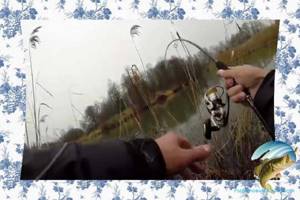
Even play is suitable for spinners such as spinners and various types of baits made of silicone material. Stepped types of postings are more suitable for the production of jig methods. If you use the jerking technique, you should use all kinds of wobblers for this type of fishing.
Experienced fishermen, when hunting for perch in August, try to try out different methods of catching minke whales, which allows them to choose the most effective one at the moment.
There are a great variety of methods and methods for catching perch, but it is unlikely that an experienced fisherman will share the real secrets of his successful fishing; most likely he will simply embellish, but will never reveal all his secrets.
Equipment for asp fishing in August
The asp bites strongly at the end of August and desperately resists when fished. To hunt it, you need a spinning rod with a large power reserve of medium or parabolic action. Test range - from 10 grams to 30 grams. A spinning reel with a size of 2500 to 3000 is installed on the rod, and a braided cord with a cross-section of 0.12 to 0.21 millimeters is secured. You can catch an asp in August at:
• Heavy wobblers (for fishing from boats in currents);
• Weighted oscillating spoons (for fishing from the shore);
• Jig baits with bombards (for depth).


